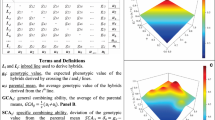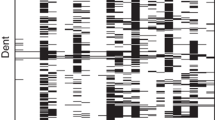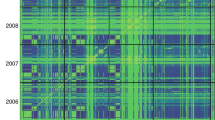Abstract
Identifying high performing hybrids is an essential part of every maize breeding program. Genomic prediction of maize hybrid performance allows to identify promising hybrids, when they themselves or other hybrids produced from their parents were not tested in field trials. Using simulations, we investigated the effects of marker density (10, 1, 0.3 marker per mega base pair, Mbp−1), convergent or divergent parental populations, number of parents tested in other combinations (2, 1, 0), genetic model (including population-specific and/or dominance marker effects or not), and estimation method (GBLUP or BayesB) on the prediction accuracy. We based our simulations on marker genotypes of Central European flint and dent inbred lines from an ongoing maize breeding program. To simulate convergent or divergent parent populations, we generated phenotypes by assigning QTL to markers with similar or very different allele frequencies in both pools, respectively. Prediction accuracies increased with marker density and number of parents tested and were higher under divergent compared with convergent parental populations. Modeling marker effects as population-specific slightly improved prediction accuracy under lower marker densities (1 and 0.3 Mbp−1). This indicated that modeling marker effects as population-specific will be most beneficial under low linkage disequilibrium. Incorporating dominance effects improved prediction accuracies considerably for convergent parent populations, where dominance results in major contributions of SCA effects to the genetic variance among inter-population hybrids. While the general trends regarding the effects of the aforementioned influence factors on prediction accuracy were similar for GBLUP and BayesB, the latter method produced significantly higher accuracies for models incorporating dominance.




Similar content being viewed by others
References
Albrecht T, Wimmer V, Auinger HJ, Erbe M, Knaak C, Ouzunova M, Simianer H, Schön CC (2011) Genome-based prediction of testcross values in maize. Theor Appl Genet 123:339–350
Bates D, Maechler M, Bolker B (2011) lme4: linear mixed-effects models using S4 classes. http://CRAN.R-project.org/package=lme4, r package version 0.999375-39
Bernardo R (1996) Best linear unbiased prediction of maize single-cross performance. Crop Sci 36:50–56
Browning BL, Browning SR (2009) A unified approach to genotype imputation and haplotype-phase inference for large data sets of trios and unrelated individuals. Am J Hum Genet 84:210–223
Charcosset A, Essioux L (1994) The effect of population structure on the relationship between heterosis and heterozygosity at marker loci. Theor Appl Genet 89:336–343
Clark S, Hickey JM, van der Werf JH (2011) Different models of genetic variation and their effect on genomic evaluation. Genet Sel Evol 43:18
Falconer DS, Mackay TFC (1996) Introduction to quantitative genetics. 4th edn. Longmans Green, Harlow
Fischer S, Möhring J, Schön CC, Piepho HP, Klein D, Schipprack W, Utz HF, Melchinger AE, Reif JC (2008) Trends in genetic variance components during 30 years of hybrid maize breeding at the University of Hohenheim. Plant Breeding 127:446–451
Ganal MW, Durstewitz G, Polley A, Bérard A, Buckler ES, Charcosset A, Clarke JD, Graner EM, Hansen M, Joets J, Le Paslier MC, McMullen MD, Montalent P, Rose M, Schön CC, Sun Q, Walter H, Martin OC, Falque M (2011) A large maize (Zea mays L.) SNP genotyping array: development and germplasm genotyping, and genetic mapping to compare with the B73 reference genome. PLoS ONE 6:e28,334
Gardner C (1963) Estimates of genetic parameters in cross-fertilizing plants and their implications in plant breeding. In: Statistical genetics and plant breeding. Comittee on Plant Breeding and Genetics of the Agricultural Board at the North Carolina State College Raleigh, NC, vol 982, pp 225–251
Gardner C, Lonnquist J (1959) Linkage and the degree of dominance of genes controlling quantitative characters in maize. Agron J 51:524–528
Goddard M (2009) Genomic selection: prediction of accuracy and maximisation of long term response. Genetica 136:245–257
Hayes BJ, Pryce J, Chamberlain AJ, Bowman PJ, Goddard M (2010) Genetic architecture of complex traits and accuracy of genomic prediction: coat colour, milk-fat percentage, and type in Holstein cattle as contrasting model traits. PLoS Genet 6:e1001,139
Ibánez-Escriche N, Fernando RL, Toosi A, Dekkers JCM (2009) Genomic selection of purebreds for crossbred performance. Genet Sel Evol 41:12
Kizilkaya K, Carnier P, Albera A, Bittante G, Tempelman R (2003) Cumulative t-link threshold models for the genetic analysis of calving ease scores. Genet Sel Evol 35:489–512
Labate J, Lamkey K, Lee M, Woodman W (1999) Temporal changes in allele frequencies in two reciprocally selected maize populations. Theor Appl Genet 99:1166–1178
Li Z, Sillanpää MJ (2012) Estimation of quantitative trait locus effects with epistasis by variational Bayes algorithms. Genetics 190:231–249
Maenhout S, De Baets B, Haesaert G (2010) Prediction of maize single-cross hybrid performance: support vector machine regression versus best linear prediction. Theor Appl Genet 120:415–427
Meuwissen TH, Goddard M (2010) Accurate prediction of genetic values for complex traits by whole-genome resequencing. Genetics 185:623–631
Meuwissen TH, Hayes BJ, Goddard M (2001) Prediction of total genetic value using genome-wide dense marker maps. Genetics 157:1819–1829
Müller P (1991) A generic approach to posterior integration and Gibbs sampling. Technical report, Purdue University # 91-09
Paradis E, Claude J, Strimmer K (2004) APE: analyses of phylogenetics and evolution in R language. Bioinformatics 20:289–290
Pikkuhookana P, Sillanpää MJ (2009) Correcting for relatedness in Bayesian models for genomic data association analysis. Heredity 103:223–237
Plummer M, Best N, Cowles K, Vines K (2010) coda: output analysis and diagnostics for MCMC. http://CRAN.R-project.org/package=coda, r package version 0.14-2
R Development Core Team (2011) R: a language and environment for statistical computing. R Foundation for Statistical Computing, Vienna, Austria. http://www.R-project.org/, ISBN 3-900051-07-0
Ramsey J, Ripley B (2010) pspline: penalized smoothing splines. http://CRAN.R-project.org/package=pspline, r package version 1.0-14
Reif JC, Gumpert FM, Fischer S, Melchinger AE (2007) Impact of interpopulation divergence on additive and dominance variance in hybrid populations. Genetics 176:1931–1934
Riedelsheimer C, Czedik-Eysenberg A, Grieder C, Lisec J, Technow F, Sulpice R, Altmann T, Stitt M, Willmitzer L, Melchinger AE (2012) Genomic and metabolic prediction of complex heterotic traits in hybrid maize. Nat Genet 44:217–220
Schaefer J, Opgen-Rhein R, Zuber V, Silva APD, Strimmer K (2012) corpcor: efficient estimation of covariance and (partial) correlation. http://CRAN.R-project.org/package=corpcor, r package version 1.6.2
Schrag TA, Melchinger AE, Sørensen AP, Frisch M (2006) Prediction of single-cross hybrid performance for grain yield and grain dry matter content in maize using AFLP markers associated with QTL. Theor Appl Genet 113:1037–1047
Stich B, Melchinger AE, Piepho HP, Hamrit S, Schipprack W, Maurer HP, Reif JC (2007) Potential causes of linkage disequilibrium in a European maize breeding program investigated with computer simulations. Theor Appl Genet 115:529–536
Van Inghelandt D, Melchinger AE, Lebreton C, Stich B (2010) Population structure and genetic diversity in a commercial maize breeding program assessed with SSR and SNP markers. Theor Appl Genet 120:1289–1299
Van Inghelandt D, Reif JC, Dhillon BS, Flament P, Melchinger AE (2011) Extent and genome-wide distribution of linkage disequilibrium in commercial maize germplasm. Theor Appl Genet 123:11–20
Xu S (2003) Estimating polygenic effects using markers of the entire genome. Genetics 163:789–801
Yan J, Shah T, Warburton M, Buckler E, McMullen M, Crouch J (2009) Genetic characterization and linkage disequilibrium estimation of a global maize collection using SNP markers. PLoS One 4:e8451
Yang W, Tempelman RJ (2012) A Bayesian antedependence model for whole genome prediction. Genetics 190:1491–1501
Zhong S, Dekkers JCM, Fernando RL, Jannink JL (2009) Factors affecting accuracy from genomic selection in populations derived from multiple inbred lines: a Barley case study. Genetics 182:355–364
Acknowledgments
This research was funded by the German Federal Ministry of Education and Research (BMBF) within the AgroClustEr Synbreed—Synergistic plant and animal breeding (FKZ: 0315528d).
Author information
Authors and Affiliations
Corresponding author
Additional information
Communicated by M. Sillanpää.
Electronic supplementary material
Below is the link to the electronic supplementary material.
Rights and permissions
About this article
Cite this article
Technow, F., Riedelsheimer, C., Schrag, T.A. et al. Genomic prediction of hybrid performance in maize with models incorporating dominance and population specific marker effects. Theor Appl Genet 125, 1181–1194 (2012). https://doi.org/10.1007/s00122-012-1905-8
Received:
Accepted:
Published:
Issue Date:
DOI: https://doi.org/10.1007/s00122-012-1905-8




